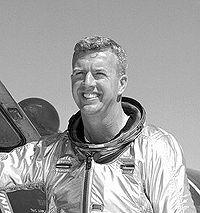
X-15 Flight 90
Encyclopedia
| Mission statistics | |
|---|---|
| Mission Name: | X-15 Flight 90 |
| Call Sign: | X-15 |
| Number of crew members: |
1 |
| Launch: | July 19, 1963 18:20:05 UTC Coordinated Universal Time Coordinated Universal Time is the primary time standard by which the world regulates clocks and time. It is one of several closely related successors to Greenwich Mean Time. Computer servers, online services and other entities that rely on having a universally accepted time use UTC for that purpose... NB-52B flying near Smith Ranch Dry Lake, NV 39°20′N 117°29′W |
| Landing: | July 19, 1963 18:31:29.1 UTC Rogers Dry Lake, Edwards AFB, CA |
| Duration: B-52 drop to X-15 wheel stop |
00:11:24.1 |
| Number of orbits: |
Suborbital |
| Apogee: | 106.01 km |
| Distance traveled: |
534 km |
| Maximum velocity: |
5,971 km/h |
| Peak acceleration: | 5g (49 m/s²) |
| Mass: | Launch 15,195 kg Burnout 6,577 kg Landing 6,260 kg |
| Crew picture | |
 |
|
| Joe Walker | |
Crew
Mission parameters
- Mass: 15,195 kg fueled; 6,577 kg burnout; 6,260 kg landed
- Maximum Altitude: 106.01 km
- Range: 534 km
- Burn Time: 84.6 seconds
- Mach: 5.50
- Launch Vehicle: NB-52B Bomber #008Balls 8Balls 8 was a NASA Boeing NB-52B mothership. It derives its nickname from its NASA tail number 52-008: leading zeroes plus the number 8. Among USAF personnel it is common practice to refer to aircraft whose tail number is a single number preceded by multiple zeros as "Balls" and the last number of...
Mission highlights
Maximum Speed - 5,971 km/h. Maximum Altitude - 106,010 m. 80 cm diameter balloon towed on 30 m line to measure air density. First X-15 flight over 100 km (a height known as the Kármán lineKarman line
The Kármán line lies at an altitude of above the Earth's sea level, and is commonly used to define the boundary between the Earth's atmosphere and outer space...
). This made Walker the first US civilian in space. First flight launched over Smith Dry Lake, NV. Experiments: Towed balloon, horizon scanner, photometer, infrared and ultraviolet. Balloon instrumentation failed.
The mission was flown by X-15 #3, serial 56-6672 on its 21st flight.
Launched by: NB-52B #008, Pilots Fulton & Bement. Takeoff: 17:19. UTC Landing: 19:04 UTC.
Chase pilots: Crews, Dana, Rogers, Daniel and Wood.
The X-15 engine burned about 85 seconds. Near the end of the burn, acceleration built up to about 4g (39 m/s²). Weightlessness lasted for 3 to 5 minutes. Re-entry heating warmed the exterior of the X-15 to 650 °C in places. During pull up after re-entry, the acceleration built up to 5g (49 m/s²) for 20 seconds. The entire flight lasted about 12 minutes from launch to landing.
| 1st 100 km Flight: X-15 Flight 90 |
X-15 Program | 2nd 100 km Flight: X-15 Flight 91 X-15 Flight 91 X-15 Flight 91 was a 1963 American human spaceflight mission, and the second and final flight in the program to achieve sub-orbital spaceflight: a flight over 100km in altitude. It was the first flight of a reused spacecraft, as plane number three flew the previous sub-orbital flight on July 19.... |

